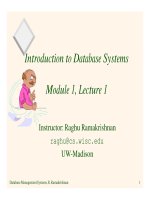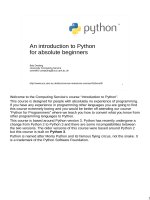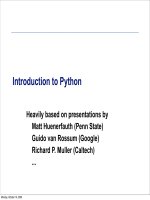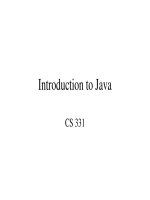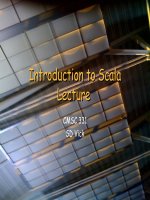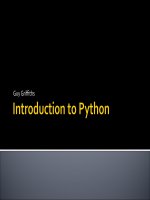Introduction to python lecture
Bạn đang xem bản rút gọn của tài liệu. Xem và tải ngay bản đầy đủ của tài liệu tại đây (446.6 KB, 87 trang )
Introduction to Python
Heavily based on presentations by
Matt Huenerfauth (Penn State)
Guido van Rossum (Google)
Richard P. Muller (Caltech)
Monday, October 19, 2009
•
Open source general-purpose language.
•
Object Oriented, Procedural, Functional
•
Easy to interface with C/ObjC/Java/Fortran
•
Easy-ish to interface with C++ (via SWIG)
•
Great interactive environment
•
Downloads:
•
Documentation: />•
Free book:
Python
Monday, October 19, 2009
2.5.x / 2.6.x / 3.x ???
•
“Current” version is 2.6.x
•
“Mainstream” version is 2.5.x
•
The new kid on the block is 3.x
You probably want 2.5.x unless you are starting from
scratch. Then maybe 3.x
Monday, October 19, 2009
Technical Issues
Installing & Running Python
Monday, October 19, 2009
Binaries
•
Python comes pre-installed with Mac OS X and
Linux.
•
Windows binaries from />•
You might not have to do anything!
Monday, October 19, 2009
The Python Interpreter
•
Interactive interface to Python
% python
Python 2.5 (r25:51908, May 25 2007, 16:14:04)
[GCC 4.1.2 20061115 (prerelease) (SUSE Linux)] on linux2
Type "help", "copyright", "credits" or "license" for more information.
>>>
•
Python interpreter evaluates inputs:
>>> 3*(7+2)
27
•
Python prompts with ‘>>>’.
•
To exit Python:
• CTRL-D
Monday, October 19, 2009
Running Programs on UNIX
% python filename.py
You could make the *.py file executable and add the
following #!/usr/bin/env python to the top to make it
runnable.
Monday, October 19, 2009
Batteries Included
•
Large collection of proven modules included in the
standard distribution.
/>Monday, October 19, 2009
numpy
•
Offers Matlab-ish capabilities within Python
•
Fast array operations
•
2D arrays, multi-D arrays, linear algebra etc.
•
Downloads: />•
Tutorial: />Tentative_NumPy_Tutorial
Monday, October 19, 2009
matplotlib
•
High quality plotting library.
•
Downloads: />#!/usr/bin/env python
import numpy as np
import matplotlib.mlab as mlab
import matplotlib.pyplot as plt
mu, sigma = 100, 15
x = mu + sigma*np.random.randn(10000)
# the histogram of the data
n, bins, patches = plt.hist(x, 50, normed=1, facecolor='green',
alpha=0.75)
# add a 'best fit' line
y = mlab.normpdf( bins, mu, sigma)
l = plt.plot(bins, y, 'r ', linewidth=1)
plt.xlabel('Smarts')
plt.ylabel('Probability')
plt.title(r'$\mathrm{Histogram\ of\ IQ:}\ \mu=100,\ \sigma=15$')
plt.axis([40, 160, 0, 0.03])
plt.grid(True)
plt.show()
Monday, October 19, 2009
PyFITS
•
FITS I/O made simple:
•
Downloads: />software_hardware/pyfits
>>> import pyfits
>>> hdulist = pyfits.open(’input.fits’)
>>> hdulist.info()
Filename: test1.fits
No. Name Type Cards Dimensions Format
0 PRIMARY PrimaryHDU 220 () Int16
1 SCI ImageHDU 61 (800, 800) Float32
2 SCI ImageHDU 61 (800, 800) Float32
3 SCI ImageHDU 61 (800, 800) Float32
4 SCI ImageHDU 61 (800, 800) Float32
>>> hdulist[0].header[’targname’]
’NGC121’
>>> scidata = hdulist[1].data
>>> scidata.shape
(800, 800)
>>> scidata.dtype.name ’float32’
>>> scidata[30:40,10:20] = scidata[1,4] = 999
Monday, October 19, 2009
pyds9 / python-sao
•
Interaction with DS9
•
Display Python 1-D and 2-D arrays in DS9
•
Display FITS files in DS9
•
Downloads: Ask Eric Mandel :-)
•
Downloads: />Monday, October 19, 2009
Wrappers for Astronomical Packages
•
CasaPy (Casa)
•
PYGILDAS (GILDAS)
•
ParselTongue (AIPS)
•
PyRAF (IRAF)
•
PyMIDAS (MIDAS)
•
PyIMSL (IMSL)
Monday, October 19, 2009
Custom Distributions
•
Python(x,y): />• Python(x,y) is a free scientific and engineering development
software for numerical computations, data analysis and data
visualization
•
Sage: />• Sage is a free open-source mathematics software system
licensed under the GPL. It combines the power of many existing
open-source packages into a common Python-based interface.
Monday, October 19, 2009
Extra Astronomy Links
•
iPython (better shell, distributed computing):
/>•
SciPy (collection of science tools): http://
www.scipy.org/
•
Python Astronomy Modules: http://
astlib.sourceforge.net/
•
Python Astronomer Wiki: />astrowiki/tiki-index.php?page=python
•
AstroPy: />rowen/AstroPy.html
•
Python for Astronomers: />sieinvens/siepedia/pmwiki.php?
n=HOWTOs.EmpezandoPython
Monday, October 19, 2009
The Basics
Monday, October 19, 2009
A Code Sample
x = 34 - 23 # A comment.
y = “Hello” # Another one.
z = 3.45
if z == 3.45 or y == “Hello”:
x = x + 1
y = y + “ World” # String concat.
print x
print y
Monday, October 19, 2009
Enough to Understand the Code
•
Assignment uses = and comparison uses ==.
•
For numbers + - * / % are as expected.
•
Special use of + for string concatenation.
•
Special use of % for string formatting (as with printf in C)
•
Logical operators are words (and, or, not)
not symbols
•
The basic printing command is print.
•
The first assignment to a variable creates it.
• Variable types don’t need to be declared.
• Python figures out the variable types on its own.
Monday, October 19, 2009
Basic Datatypes
•
Integers (default for numbers)
z = 5 / 2 # Answer is 2, integer division.
•
Floats
x = 3.456
•
Strings
• Can use “” or ‘’ to specify.
“abc” ‘abc’ (Same thing.)
• Unmatched can occur within the string.
“matt’s”
• Use triple double-quotes for multi-line strings or strings than contain both ‘
and “ inside of them:
“““a‘b“c”””
Monday, October 19, 2009
Whitespace
Whitespace is meaningful in Python: especially
indentation and placement of newlines.
•
Use a newline to end a line of code.
• Use \ when must go to next line prematurely.
•
No braces { } to mark blocks of code in Python…
Use consistent indentation instead.
• The first line with less indentation is outside of the block.
• The first line with more indentation starts a nested block
•
Often a colon appears at the start of a new block.
(E.g. for function and class definitions.)
Monday, October 19, 2009
Comments
•
Start comments with # – the rest of line is ignored.
•
Can include a “documentation string” as the first line of any
new function or class that you define.
•
The development environment, debugger, and other tools use
it: it’s good style to include one.
def my_function(x, y):
“““This is the docstring. This
function does blah blah blah.”””
# The code would go here
Monday, October 19, 2009
Assignment
•
Binding a variable in Python means setting a name to hold a
reference to some object.
• Assignment creates references, not copies
•
Names in Python do not have an intrinsic type. Objects have
types.
• Python determines the type of the reference automatically based on the
data object assigned to it.
•
You create a name the first time it appears on the left side of
an assignment expression:
!x = 3
•
A reference is deleted via garbage collection after any names
bound to it have passed out of scope.
Monday, October 19, 2009
Accessing Non-Existent Names
•
If you try to access a name before it’s been properly created
(by placing it on the left side of an assignment), you’ll get an
error.
>>> y
Traceback (most recent call last):
File "<pyshell#16>", line 1, in -toplevel-
y
NameError: name ‘y' is not defined
>>> y = 3
>>> y
3
Monday, October 19, 2009
Multiple Assignment
•
You can also assign to multiple names at the same time.
>>> x, y = 2, 3
>>> x
2
>>> y
3
Monday, October 19, 2009
Naming Rules
•
Names are case sensitive and cannot start with a number.
They can contain letters, numbers, and underscores.
bob Bob _bob _2_bob_ bob_2 BoB
•
There are some reserved words:
and, assert, break, class, continue, def, del, elif,
else, except, exec, finally, for, from, global, if,
import, in, is, lambda, not, or, pass, print, raise,
return, try, while
Monday, October 19, 2009

